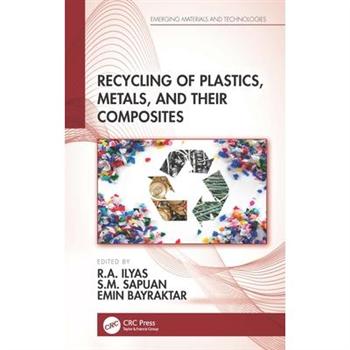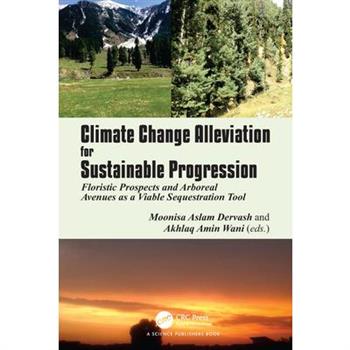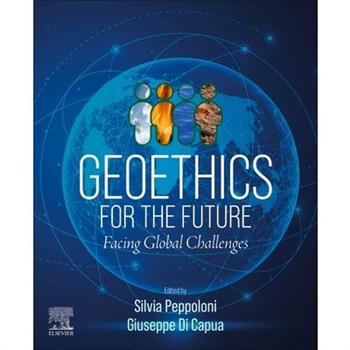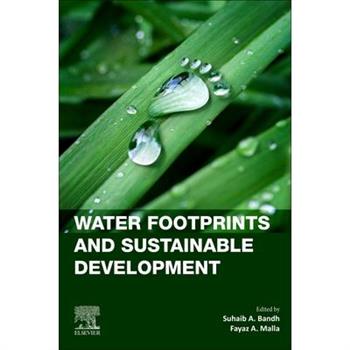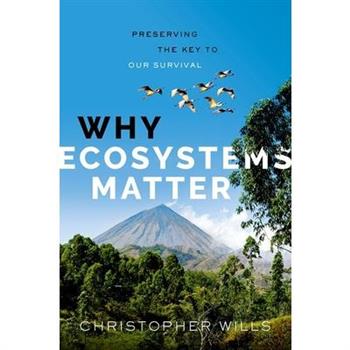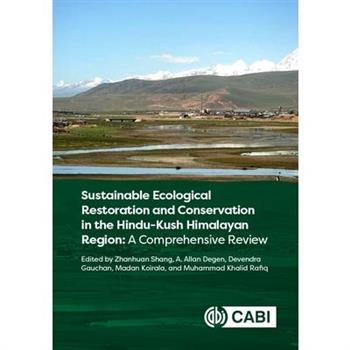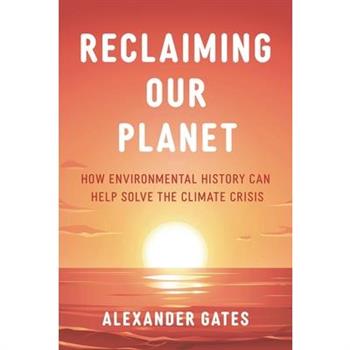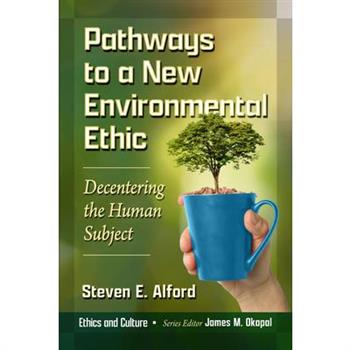Sustainable Microbial Technologies for Valorization of Agro-Industrial Wastes
This book provides an overview of the different aspects of microbial bioconversion methodologies for valorization of underutilized wastes of varied nature. It covers microbiological/biotechnological aspects, environmental concerns, bioprocess development, scale-up aspects, and opportunities in microbial valorization at commercial scale.
Recycling of Plastics, Metals, and Their Composites
Having a solid understanding of materials recycling is of high importance, especially due to the growing use of composites in many industries and increasingly strict legislation and concerns about the disposal of composites in landfills or by incineration. Recycling of Plastics, Metals, and Their Composites provides a comprehensive review of the recycling of waste polymers and metal composites. It provides the latest advances and covers the fundamentals of recycled polymers and metal composites, such as preparation, morphology, and physical, mechanical, thermal, and flame-retardancy properties.FEATURES Offers a state-of-the-art review of the recycling of polymer composites and metal composites for sustainability Describes a life-cycle analysis to help readers understand the true potential value and market for these recycled materials Details potential applications of recycled polymer and metal composites Includes the performance of natural fiber-reinforced recycled thermoplastic polymer composites under aging conditions and the recycling of multi-material plastics Covers recycling technologies, opportunities, and challenges for polymer-matrix composites This book targets technical professionals in the metal and polymer industries as well as researchers, scientists, and advanced students. It is also of interest to decision makers at material suppliers, recycled metal and polymer product manufacturers, and governmental agencies working with recycled metal and polymer composites.
Climate Change Alleviation for Sustainable Progression
This volume is collection of chapters on the exploration, research and potential of various vegetation types. The book aims to provide in-depth information on carbon confiscation focused to deal with clean development mechanism and green economy.
Liquid and Crystal Nanomaterials for Water Pollutants Remediation
Nanoscience-technology is playing vital role in multidisciplinary research due to its unique characteristics at nanoscale as compared to bulk materials. This book focuses on generation of liquid and crystal nanomaterials for environmental remediation.
Enzymes in Environmental Management
Enzymes can help break down plastic waste and make it less harmful to the environment. They can also be used to treat various types of waste, including agricultural and food waste, and wastewater. Enzyme engineering is an important part of chemical biotechnology and helps to keep the environment clean. Making clean and renewable fuels is a priority, and many strategies are being developed to achieve this goal. However, food waste is still a major problem that can harm the environment because most disposal methods are not eco-friendly. This volume aims to inform readers about the latest developments in the use of enzymes for environmental management. This comprehensive resource provides a detailed overview of how enzymes can be used in various sectors to promote ecological sustainability. It covers the composition, properties, characterization, chemistry, and applications of different enzymes in emerging and eco-friendly approaches to waste treatment. It also highlights the latest advancements in sustainable technology and biotechnology enzymes. The book is divided into sections that feature various enzymes used for treating resistant pollutants in wastewater, enzymatically degrading synthetic plastics, and engineering enzymes to impact environmental sustainability positively. It also covers enzymes used in the valorization of waste, enzyme technology in biofuel production, and the recovery of enzymes from food waste. Each chapter presents the enzymes' chemical, physical, and biological attributes and reviews the recent research conducted in this emerging field. The authors hope this document will inspire scientists to explore novel chemical, material, and energy sources in the future and to continue developing innovative applications for enzymes in environmental management.
Oil Spill Occurrence, Simulation, and Behavior
Oil Spill Occurrence, Simulation, and Behavior provides practical insight into oil spills and their causes, impacts, response and cleanup methods, simple and advanced modeling of oil spill behavior, and oil spill simulation techniques. Discusses various sources of oil spills and major accidents Includes case studies on the 2010 Gulf of Mexico oil spill, including environmental, economic, and political impacts, modeling and behavior as well as response and cleanup methods Introduces some commercial softwares on predicting oil movement and spreading on water Describes properties and characteristics of crude oil and its products needed for simulation and prediction of behavior of an oil slick Written as an applied book with minimal math and theory, making it accessible to a wide range of readers The book includes more than 100 unique and informative images in color This essential book is aimed at professionals, academics, and scientists in the fields of chemical engineering, petroleum engineering, environmental engineering, marine and ocean engineering working on the simulation and modeling, mitigation, and prevention of oil spills.
Plasmonic Nanosensors for Detection of Aqueous Toxic Metals
Delving into the development of plasmonic nanosensors to detect toxic heavy metal ions in aqueous media, this book explores a significant and burgeoning branch of nanosensor technology based on plasmon resonance and serves as a guide for conducting research in this area.
Sustainable Urban Mining of Precious Metals
This book provides a detailed review of extraction techniques for urban mining of precious metals like gold, silver and platinum groups. Periodical growth levels of spent sources, management necessities and correlation with circular economy, merits and demerits of methods, and environmental impact of every process is described.
Lake Functioning
This book explores the interconnections of internal phosphorus loading, cyanobacteria, and climate change and their role in determining water quality in freshwater.
The city invades the forest
This book analyses the relationship between some of the communities located in and around the Tijuca National Park (PARNA-Tijuca), and identifies the pressures resulting from occupation of these areas. PARNA-Tijuca is a Conservation Unit made up of four sectors: Tijuca Forest, Serra da Carioca, Pedra Bonita/Pedra da G獺vea and Pretos Forros/Covanca. Based on the results found, it was possible to verify that the region studied is very vulnerable, as it is an urban forest, which is part of the territory of a large metropolis, thus suffering pressure from the dynamics of the city, which has been invading the forest and causing negative environmental impacts on it.
Nanosensors for Futuristic Smart and Intelligent Healthcare Systems
The main focus of this book is the basic concepts of nanomaterials and sensing paradigms for medical devices based on nanosensor technology. The book will be valuable to researchers, engineers, scientists interested in the field of healthcare for monitoring health status in real-time.
Virus Bioinformatics
Viruses are the most numerous and deadliest biological entities on the planet, infecting all types of living organisms--from bacteria to human beings. The constantly expanding repertoire of experimental approaches available to study viruses includes both low-throughput techniques, such as imaging and 3D structure determination, and modern OMICS technologies, such as genome sequencing, ribosomal profiling, and RNA structure probing. Bioinformatics of viruses faces significant challenges due to their seemingly unlimited diversity, unusual lifestyle, great variety of replication strategies, compact genome organization, and rapid rate of evolution. At the same time, it also has the potential to deliver decisive clues for developing vaccines and medications against dangerous viral outbreaks, such as the recent coronavirus pandemics. Virus Bioinformatics reviews state-of-the-art bioinformatics algorithms and recent advances in data analysis in virology. FEATURES Contributions from leading international experts in the field Discusses open questions and urgent needs Covers a broad spectrum of topics, including evolution, structure, and function of viruses, including coronaviruses The book will be of great interest to computational biologists wishing to venture into the rapidly advancing field of virus bioinformatics as well as to virologists interested in acquiring basic bioinformatics skills to support their wet lab work.
Synthetic Sorbent Materials Based on Metal Sulphides and Oxides
This book focuses on development of inorganic nanomaterials for removal of metallic species from the aqueous environment. It investigates problems of controlled synthesis of these materials and the effect of their morphological characteristics on their sorption capacity.
Geoethics for the Future
Geoethics for the Future: Facing Global Challenges offers a set of points of view on highly topical issues in geosciences and beyond, including societal relevance of geosciences, georesources, sustainable development, geoeducation, georisks, data, as well as philosophical, legal, political, scientific considerations about anthropogenic global changes and the Anthropocene, enabling readers to acquire multifaceted knowledge on topics of global relevance in the 21st Century. This book explores topics vital to our historical moment and the future of human societies, through the analyzes by scholars with different disciplinary backgrounds, emphasizing the need for new cultural and scientific frameworks to address global issues. It aims to foster multidisciplinary and transdisciplinary approaches for problem-solving, by integrating diverse knowledge and visions to effectively tackle urgent global challenges.Serving as a significant milestone in geoethics, this book provides academics, researchers and students with insights into the ethical and societal dimensions of various challenges arising from human impact on the Earth system.
Water Footprints and Sustainable Development
Water Footprints and Sustainable Development serves as the sole comprehensive volume of the role of waste management for sustainable development. It provides an overview of Global Scenario of water footprints in water smart cities and technologies and investigates the critical factors that enable the sustainable developments of various industries in respect to water resources management. The goal of this book is to introduce the reader to the current technologies used for reducing water footprints, and to offer the necessary information and tools for sustainable development.
Toxic Metals Contamination
This book presents the main sources of toxic metals emission, demonstrate the state of the art of waste disposal and valuation techniques, especially solids, and wastewater treatment.
Plant species used in areas degraded by mining
Mineral exploration activities are of great importance and contribution to the Brazilian economy. The requirement for PRAD and environmental care, as described in the EIA/RIMA processes during mine closure, are guarantees that the environment will be returned with biodiversity quality. Soil transposition, seed banks, branch transposition, natural and artificial perches, planting seedlings and nucleation are the environmental techniques most commonly used in environmental restoration. Through a bibliographical review of 18 scientific articles, doctoral theses and digital platforms, this research seeks to present the plant species and families most used in the recovery of degraded areas in iron ore mining. The results showed that the most common species were guandu beans, bragatinga, eucalyptus, fat grass, brachiaria, pau brasil, arnica mineira and skunk grass. The Asteraceae, Melastomataceae, Podaceae and Orchidaceae families had the highest number of species cited. It can be concluded that plant diversity is low, necessitating a plant inventory prior to development, as well as a seed bank.
Improving the management of national natural resources
The paper studies the problem of nature management. The essence of natural resources management is to ensure the preservation, restoration and, where necessary, improvement of favourable natural conditions for human life, development of production and culture by means of scientifically based regulation of society's impact on nature. Here, economic and legal mechanisms of environmental protection should be developed. This issue in the conditions of transition to market relations should be among the most urgent and most important problems of economic and social development.
Why Ecosystems Matter
Every one of Earth's teeming ecosystems is an evolutionary cauldron Christopher Wills's claim has its roots in an insight from Charles Darwin: the interactions between species in an ecosystem are a powerful driver of evolution. In this book Wills describes how, by using the latest genetic techniques, we are probing ecosystems and discovering that even the most apparently barren of them are rich in variety, especially of microbes. Exploring the many ways in which ecosystems have coped with past change, and how rapidly an ecosystem can develop complexity, Wills illuminates a pathway of hope for the natural world that we have so damaged and depleted. Our new genetic knowledge can help these evolutionary cauldrons to continue brewing richness and diversity, the better to heal our living world and to enable our own survival.
General ecology
This course in General Ecology is intended for students in the Preparatory Classes for the 2nd year of the Natural and Life Sciences at the High School of Agronomy- Mostaganem. This educational document in no way replaces the books on the subject available in the library. It is simply a summary of a few choice titles, old and recent, covering the syllabus of the teaching unit in question. The course is presented in five chapters with sufficient illustrations to facilitate understanding. The first chapter focuses on a few general points about ecology, namely the concept of the ecological system and the various areas of intervention. The second chapter presents the environment and its interactions with the various elements that surround it. The third chapter deals with abiotic factors, i.e. the complexity of climatic and edaphic elements. The fourth is devoted to biotic ecological factors, covering all the interactions between different living beings. Finally, the fifth deals with the structure and functioning of the various types of ecosystems that characterize our biosphere.
Handbook of Complementary, Alternative, and Integrative Medicine
Volume 1 focuses on complementary, alternative, and integrative medicine (CAM) education. Its 20 chapters cover CAM education history, needed competencies, and curriculum reform, among other topics. It is Volume 1 of 6 that describe the education, practice and research related issues and the efficacy and safety of CAM in treating various conditions. The purpose of these six volumes (sold individually or as a set) is to explain how complementary, alternative, and integrative medicine is practiced around the world; to share the best practice/experiences in terms of education, practice and research; and identify the challenges and suggest recommendations to overcome the identified challenges.Key Features: Addresses worldwide issues of education, training, assessment, and accreditation in complementary and alternative medicine Deals with such hot topics as access/equitable access, online education, and quality and accreditation Serves as part of a six-volume comprehensive treatment of complementary, alternative, and integrative medicine as practiced around the world
Pollination of crops by bees
Investigations carried out during 2016, 2017 and 2018 in the Tizi-ouzou region on the Apoids pollinating six market garden plants and one fruit tree, the orange tree, revealed that the honey bee is the main pollinator of zucchini, watermelon and orange tree. This bee is also the main visitor to watermelon, alongside four other solitary bee species (Nomada sp. Ceratina saundersi, Ceratina cucurbitina, and Lasioglossum pauxillum). The two Halictidae L. pauxillum and L. malachurum appear to be the main pollinators of lettuce and onion. By contrast, the two legumes, broad bean and chickpea, are mainly pollinated by other species of the Apidae family: Eucera numida, Eucera decolorata and Eucera eucnemidea. The Megachilidae Lithurgus chrysurus is also the most frequent visitor of chickpeas. Our results also show that bees' foraging activity follows the anthesis of the flowers studied. It begins as soon as the first flowers open, and intensifies as the number of open flowers increases.
Historical Context of Environmental Science
Delve into the expansive world. Environmental Science, where the intricate interplay of nature, society, and technology unfolds. This comprehensive guide delivers an insightful exploration of the fields profound historical roots, modern movement, and pivotal milestones shaping our planets future. Discover interdisciplinary methods, ethical considerations, and career pathways that illuminate the crucial role of environmental science. sustainable development and global policies. From ancient philosophies to cutting-edge technologies, this resource equips readers with the knowledge to tackle contemporary challenges like climate change, biodiversity loss, and pollution. Join the movement toward a sustainable future and become an informed advocate for the environment.inof
Socio-environmental diagnosis
The Amazon region is rich in terms of biodiversity, both plant and animal. Therefore, knowing how to manage this biological diversity is fundamental to sustaining it. This region is home to the municipality of Igarap矇-A癟u in the north-east of Par獺, the target of this study. According to the Brazilian Institute of Geography and Statistics (IBGE), the municipality covers 786 km簡 and has a population of 35,887 inhabitants, 63.82% of whom live in urban areas, according to the 2010 census. In this context, the aim was to carry out a socio-environmental diagnosis of the municipality of Igarap矇-A癟u, highlighting the physiographic aspects of the study area of the aforementioned municipality, among them: climate, vegetation, soils, hydrography, geomorphology, geology, biodiversity, as well as establishing the socio-economic relationship of the study site. It also aims to identify the region's environmental problems and suggest possible proposals to favour socio-environmental improvements.
Planet Aqua
What would happen if we were to awaken one day and suddenly realize that the world we live in appeared eerily alien, as if we'd been teleported to some other distant world? That frightening prospect is now. Our planetary hydrosphere, which animates all of life on Earth, is rebelling in the wake of a global warming climate, spurring biblical spring floods, devastating summer droughts, heatwaves, and wildfires and powerful autumn hurricanes and typhoons, wreaking havoc on ecosystems and society.For too long we have misjudged the very nature of our existence and to what we owe our lifeline. We have come to believe that we live on a land planet when the reality is that we live on a water planet, and now the Earth's hydrosphere is rewilding in the throes of a changing climate, taking our species and our fellow creatures into a mass extinction event as it searches for a new equilibrium.Jeremy Rifkin calls on us to rethink our place in the universe and realize that we live on Planet Aqua. He takes us on a new journey into the future where we will need to reassess every aspect of the way we live - how we engage nature, govern society, conceptualize economic life, educate our children, and even orient ourselves in time and space. The next stage in the human journey is to rebrand our home Planet Aqua and learn how to readapt to the waters of life.Underpinned by robust research, this major new work by one of the world's leading public intellectuals aims to redefine the very core of our existence on Planet Aqua. Also available as an audiobook.
Eco Science Advances
Discover the groundbreaking field of eco science with this comprehensive guide.From the principles of ecology and biodiversity conservation to advancements in eco technology and the role of policy and governance, this book offers a panoramic view of sustainable development and future directions.Packed with valuable insights and practical strategies, it is a must-read for anyone passionate about creating a greener future.
Effects of Illegal Gold-Mining on the Environment
Cherekpong Traditional area which is a gold mining community in the District is notable of countless environmental problems such as soil erosion, depleting soil and vegetation cover, noise and air pollution, loss of biological diversity, land degradation and food insecurity. Despite the above challenges, the illegal mining in the community serves as the main employment to the youth of the community, income generation and population increase but there appears to be no systematic model on how to approach illegal mining, particularly concerning the negative effects.
Environmental Challenges and Conservation Strategies
The study of environment is crucial for sustaining life on Earth, providing essential resources like clean air, water and food. However, human activities such as deforestation, industrialisation, and pollution have led to significant environmental issues. These include climate change, loss of biodiversity, depletion of natural resources, pollution etc. Resolving these problems requires global cooperation and action. Solutions involve transitioning to renewable energy sources, adopting sustainable practices in agriculture and industry, conserving and restoring ecosystems, reducing waste and pollution, and promoting environmental education and awareness. This book emphasising the critical importance of environmental issues and the measures needed for conservation alongwith covers the syllabus of undergraduate courses in Environmental Studies and Disaster Management. By addressing these subjects comprehensively, the book aims to educate students about the complexities of environmental challenges and equip them with knowledge and skills to contribute effectively to environmental conservation and disaster resilience efforts.
Success Stories in Environmental Science
Environmental Science: Exploring the Interdisciplinary World of Conservation, Restoration, Agriculture, and Renewable Energy. Discover the historical perspectives, theoretical frameworks, methods, and success stories in environmental science and learn how to tackle the challenges of climate change, biodiversity loss, food systems, and sustainable energy.
The Origin of Life
This book provides a logical and testable explanation about the origin of the universe. It explains that the universe did not just come by chance but was carefully created by two antagonistic physical forces. It gives a step by step accounts of the processes that brought everything into existence. It again gives satisfactory answers to many unanswered questions on life and the universe origin. It identifies by name the forces that created our universe. The book also predict that in the near future, the different human races will begin reproducing infertile offspring among themselves. And that the world will soon be dominated by miniature size organisms. It is the first scientific work to provide a mechanism for natural selection. And confirms the notion that couples turn to resemble after a period of time.
Ecology and Diversity
Ecology and Diversity: Life Sciences Lab Manual provides innovative and succinct lab coursework for core topics in introductory biology, including: The Scientific MethodPlant Diversity and Dichotomous KeysCommunity InteractionsPlant PopulationsThe Human PopulationBiogeochemical CyclesBacteria and Protist DiversityAnimal DiversityDesigned by faculty for use in their own classroom, this lab manual offers high-quality materials at affordable prices.
From excess food to food shortages in the society of abundance
Sharing the guidelines and concerns of the United Nations Organisation, expressed in 2015 in the Sustainable Development Goals and whose main goals are to "End hunger, achieve food security and improved nutrition and promote sustainable agriculture" (SDG2) by 2030 and the need to "Ensure sustainable production and consumption patterns" (SDG12), we propose to reflect on the problem of combating food waste and on social actions aimed at mitigating it. It is interesting to understand the socially constructed relationship between overconsumption and food waste on the one hand and food shortages on the other, as this seems to generate social inequalities and injustices. With a view to the Circular Economy and using the various levels of the food waste hierarchy, we will learn about practices and initiatives created at each level, always favouring prevention/reduction and food donation, as they are those that can be adopted before food becomes food waste, and are therefore to be favoured from a social, economic and environmental perspective.
Reclaiming Our Planet
Offers hope for beating climate change by highlighting moments in history in which humans have successfully reversed environmental damage.The popular media is full of doomsday scenarios regarding the environment and especially climate change. Perhaps these scare-tactics are necessary to call the public to action, however, they also have the unintended effect of convincing people that there is no hope for our planet. In Reclaiming Our Planet: How Environmental History Can Help Solve the Climate Crisis, Alexander Gates explores past environmental crises that humanity has faced and successfully addressed to encourage readers that slowing and preventing climate change is possible. From the elimination of toxins and pesticides, such as lead and DDT, to an increase in Bald Eagle populations, Gates demonstrates that concerted efforts from motivated activists and scientists can and do lead to victories. Set against the backdrop of these human victories over pollution, Reclaiming Our Planet also evaluates if our current approaches to are appropriate and highlights what more could be done. From solar panels and wind turbines to electric vehicles, Gates analyzes the advantages and drawbacks of such technologies along with possible new innovations in geothermal, algal fuels, and nuclear energy. Readers will be left optimistic that by learning from our history, the planet may still have a bright and healthy future ahead.
Ecological Implications of Non-Standardized Crude Oil Refineries
This book, explore the implications of non-standardized refineries on the mangrove ecosystem in the Niger Delta region of Nigeria. The Niger Delta region is home to one of the largest blue carbon sinks and mangrove ecosystems in the world, providing important habitat for a diverse range of species and playing a crucial role in carbon sequestration. However, the presence of non-standardized refineries in the area has raised concerns about the potential environmental impacts on the delicate ecosystem. These refineries often operate without regulations or oversight, leading to pollution of waterways, destruction of habitat for various species, and disruption of the natural food chain. This book examines the specific ways in which these non-standardized refineries are affecting the mangrove ecosystem and explores potential solutions to mitigate their negative effects. The book study shows that non-standardized refineries in the region are significant sources of pollution, leading to mangrove destruction. The book revealed the environmental issues, risks, and ecological significance of mangroves in the Niger Delta.
Influence of hydro-edaphic factors on the igap籀 tree community
Several studies have described the clear influence of the flood pulse on the differential distribution of species and the existence of distinct phytophysiognomies along the topographic gradient in the floodplain. However, few similar studies have been carried out in igap籀, and the results obtained so far allow us to verify that there is some variation in species composition according to the duration of flooding; however, the existence of species zonation along the gradient has not been described so far. The aim of this study was to verify the influence of hydro-edaphic factors on the floristic composition, richness, diversity, basal area and density of individuals in the igap籀 forest of the Ja繳 National Park (Amazonas, Brazil), as well as to identify the existence of species zonation along the flooding and edaphic gradients.
Ecohydrodynamic Modeling as an Aid to Wetland Management
The Banhado do Taim is an important wetland area in southern Brazil and is essential for maintaining the region's ecological stability. The main economic activity in the area surrounding the ESEC is the planting of irrigated rice, a process that demands large amounts of water, which is captured from the region's lagoons, causing the levels of the lagoons and the marsh to drop. One of the ways of investigating how species are impacted by this activity is through the Habitat Suitability Indices (HSAs) method, which integrates information on the environmental conditions necessary for species to survive and their interdependence. The development of HIAs helps to develop strategies for managing water resources and conserving biodiversity, and has been widely used in wetland regions. To this end, five new IAHs were developed for the following species: reed bunting (Scirpus californicus), black-crowned godwit (Plegadis chihi) and loggerhead (Mycteria americana), and the reptiles yellow-bellied caiman (Caiman latirostris) and tiger turtle (Trachemys dorbigni).
Cyber-Physical Systems and Industry 4.0
This new work explores the growth of information and communication technologies with an emphasis on cyber-physical systems and security management of these systems. This volume discusses and analyzes the various effective practical applications of CPS, which involves the integration of the physical process with embedded computation and network monitoring along with feedback loops from physical systems.The authors identify the best set of applications and discuss the drawbacks of existing systems. The book provides a broad outlook on the applications of cyber-physical systems along with case studies and examples in healthcare, automotive electronics, industrial automation, environment monitoring, agriculture, and applications in civil and mechanical sectors. Topics include using an energy management system in smart grids, implementing an intelligent traffic management system, warehouse tracking and monitoring, medical cyber-physical systems security, remote healthcare monitoring, and more.
Pathways to a New Environmental Ethic
We live under the threat of humanity's self-inflicted extinction. While technological approaches to climate mitigation are admirable, our ecological crisis results ultimately from an inherited, unexamined concept of selfhood and a misconceived view of nature. The received idea that our self exists inside our skull engenders an assumption that nature is "out there," with devastating results. This book explores three new ways of thinking about the interrelation of ourselves and "nature" Merleau-Ponty's notion of embodiment, the connection between enactivism and affordances, and object oriented ontology. These approaches to selfhood reorder our moral obligations: What are our responsibilities to ourselves, our children, and nature itself? An embodied ethic can transcend cultural biases and offer a new way of confronting climate change. To meet environmental challenges, we need to change our minds about our minds.
Groundwater Management for Sustainable Agriculture in the North China Plain
This book is a unique text that explores recent research on the management of sustainable groundwater use in the North China Plain (NCP), where aquifers are suffering the most severe over-pumping in the world and have caused serious ecological degradation. It contains research conducted by the editor and his teams on several projects over the past 18 years.Key topics covered include: comprehensive scheme and pathways to achieve sustainable groundwater management description of theoretical basis for water saving and technologies developed in practice at field scale adjusting cropping patterns and planting structure to reduce the cultivation intensity to a suitable extent soft measures such as water metering, pricing, and water marketing being applied in groundwater management practice in the NCP It will be an invaluable resource to graduate students, education and research staff, and agriculture or water resources authorities.
Huangpu River
This book, titled "Huangpu River: the Evolution and Treatment of Water Pollution," is a passionate endeavor stemming from the author's deep love for Shanghai's Huangpu River and a commitment to water environment protection. The book is a comprehensive guide aimed at documenting the river's water pollution history, analyzing current water quality, and offering scientific management strategies.The Huangpu River, an emblem of Shanghai, is at the heart of the city's ecological health.The book is structured into several sections: Historical Review, Analysis of the Current Situation, Case Study, Governance Strategies and Future Outlook.The book serves as a valuable resource for policymakers, environmental professionals, researchers, and the public, aiming to deepen their understanding of the Huangpu River's past, present, and future, and to encourage active participation in water environmental protection initiatives.
Green Nanomaterials
Recent technological advancements in green nanotechnology have opened a brand-new avenue for research and development in the field of medicinal plant-mediated nanoparticles, biopolymers, biotechnology, and antimicrobial and biomedical research. This new volume explores several eco-friendly technologies in green materials synthesis, which are of considerable importance. It takes an inter- and cross-multidisciplinary approach to the green chemistry of nanoengineering and green nanotechnology application in materials research. It provides informative coverage of this exciting and dynamic new field as well as relates the fundamentals of soft-nanomaterials fabrication and spectroscopic integration.The book explores bio-inspired self-assembly green nanomaterials for multifunctional applications as well as the design and synthesis of green polymeric nanomaterials for several pharmaceutical and biomedical applications, including biosensors, drug delivery, antimicrobial applications, etc. Also discussed is the fabrication of green polymer nanocomposites from waste and natural fibers, such as chitin fiber, chitin whisker fiber, cellulose fiber, nanocellulosefiber, eggshells, and cotton waste.
Sustainable Engineering, Energy, and the Environment
This book takes a unique interdisciplinary look at the latest developments, advances, and trends in the interrelated areas of sustainable engineering, energy, and the environment, focusing on environmental engineering for renewable and green energy. It looks at new research and studies on a variety of topics in green nanotechnology, green processing and solar energy, sustainable energy policies, biofuels, fuel cells, and much more.The first section of Sustainable Engineering, Energy, and the Environment: Challenges and Opportunities looks at myriad issues in sustainable energy, such as sustainable urbanism through space planning and residential building design, a method to convert vibrations from mechanical work into power, energy grid maintenance, mathematical modeling and time analysis of various mechanical activities, and more. Topics on sustainable energy include voltage systems for stand-alone nanogrids, new sources for biodiesel production, solar energy conversion, protection equipment for windmill towers, etc. The section on sustainable environment explores issues such as industrial water recycling, regeneration of spent-activated carbon in pharmaceutical production, smell mitigation and recovery of fuel from waste, the water footprint of agriculture, etc.Key features Presents advances and developments in the areas of engineering, energy, and environment under sustainable development Examines potential issues of understanding of green buildings and their energy efficiency Presents case studies on sustainable urbanization Presents novel clean technology applications for attaining environmental sustainability Assesses green auditing and natural capital accounting Describes relevant experimental techniques This book features important contributions from scientists, academicians, and professionals on the latest developments and advances in the interrelated fields of sustainable engineering, energy, and environment.
Transformative Participation for Socio-Ecological Sustainability
We, as humans, are currently facing urgent socio-ecological challenges (climate change, demographic increase, booming inequalities, etc.). These challenges are reinforced by systems of financial control at the international level, extractive natural resources strategies, lack of effective democracies, the surge in conflicts and wars, etc. This book is based on the assumption that these challenges cannot be faced without the enhanced participation of all stakeholders-from citizens to policy-makers-in the decisions that affect our social-ecological systems. This means that stakeholders must no longer simply be informed, but acquire the capacities to decide, act and adapt autonomously. In this sense, participation must be transformative. This book argues that this transformation needs to be accompanied by approaches, methods and concrete feedbacks. Therefore, this book aims to give an account of a diversity of practices and methods used to involve the various stakeholders, including the public, in transformative decision-making towards socio-ecological sustainability. It answers questions such as: How to engineer a participatory process? How can facilitators acquire the skills needed to facilitate such a process? How can role-playing games support decision and change? How to design territorial development plans with thousands of citizens? What digital platform can be designed to support participatory policy making? How can the impact of a participatory process be monitored and evaluated? What is the role of experts in these processes?
Entrepreneurship in Renewable Energy Technologies
This book focusses on various options of taking up ventures for starting entrepreneurship in small/large scale in the field of renewable energy technologies.
Environmental assessment and forecasting of urban forestry waste
Urban tree management generates biomass waste, consisting of branches, leaves, fruit and trunks. This biomass waste has the potential to be used as an energy source, especially in industry and commerce. With this in mind, this study carried out an environmental assessment and forecast of waste from Jo瓊o Pessoa's urban tree plantations as an energy alternative. The objectives were: i) to diagnose and plan the maintenance of urban tree planting in Jo瓊o Pessoa; ii) to assess the environmental impacts and analyze different scenarios for waste from urban tree planting in Jo瓊o Pessoa, with a view to including it in the Clean Development Mechanism (CDM), and iii) to analyze the forecast volume of waste from urban tree planting in Jo瓊o Pessoa. In order to achieve the objectives, an inventory of urban tree planting was carried out using simple random sampling, a Life Cycle Assessment (LCA) was developed using the IPCC 2013 GWP 100a method, and models from the ARIMA (Autoregressive Integrated Moving Average) family were applied.
Ecology, Biodiversity and Systematics
"Ecology, Biodiversity, and Systematics" digs deeply into the concepts of biodiversity, the principles of ecology and the delicate web of life. The book provides a complete picture of the mechanisms that support life on Earth, from the fundamental ideas of ecological interactions to the intricacies of global biodiversity. The book is an important resource for academics, students and anybody who is interested about the natural world because it incorporates the most recent research with real-life case studies. In addition, the book offers a plethora of recognition of the interconnectedness of ecology, biodiversity and systematics. The approach projected in the book is far-reaching, benefiting students, researchers and teachers. As the entire world is facing incessant challenges, the principles of care and empathy in education offer a powerful framework for nurturing the potential of every learner and creating a more compassionate and equitable world able to mitigate climate change and global warming impacts.






